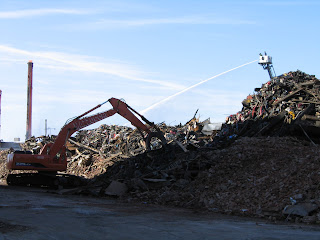In our previous blog post on the Professional Abatement Contractors of New York's (PACNY's) 16th Annual Environmental Conference, we mentioned that Dr. Stephanie Ostrowski, of the New York State Department of Health's Environmental Laboratory Approval Program (ELAP), was one of the presenters. Dr. Ostrowski's presentation, as we mentioned in our blog, included lengthy discussions on vermiculite and ceiling tiles.
The discussion regarding ceiling tiles included reviewing the decision trees she provided us to help explain the analysis process for regular bulk samples and samples required to undergo gravimetric reduction. Analysis of friable bulk sample (material) must use analysis method 198.1, while non-friable, organically bound (NOB) bulk material must use analysis method 198.6/198.4. Visit my website under Resources for the copy of the decision trees she provided us. Her explainations were excellent and the decision trees did make it easier to understand.
There was also some discussion regarding whether this meant that ceiling tiles were considered NOBs and hence could be removed under the In-plant regulations of New York State Department of Labor (NYSDOL) Industrial Code Rule 56 (ICR56). Mr. Chris Alonge of NYSDOL came to the microphone and immediately put that issue to rest, saying that ceiling tiles are not considered non-friable, so as such cannot be removed under the In-plant operations section of the regulation. This year's conference was as informative as usual, a great job was done by PACNY, Deborah Johnson of Aramsco, Darren Yehl of LeChase Construction Services and Kevin Hutton of Cornerstone Training Institute.
Future Environment Designs Training Center specializes in asbestos, indoor air quality, industrial hygiene, and occupational safety training programs. We offer New York State asbestos and mold certification courses. We design, develop, and maintain the various indoor air quality, asbestos, and safety programs that are Keeping Your Employees Safe.
Search This Blog
Thursday, April 26, 2012
Friday, April 13, 2012
More Dangers Related To Toxic Dusts
In our current newsletter (find it at www.futureenv.com), we discuss the hazards of toxic dust at demolition and disaster sites. Three new studies from California seem to support my points regarding the dangers of the dust. Indoor Environment Connections in the February 2012 issue discusses the findings of these studies linking exposure to fine-particulate matter to heart disease.
These study defined particulate matter as a complex blend of substances ranging from dry solid fragments, solid-core fragments with liquid coatings and small droplets of liquid. These particles vary in shape, size and chemical composition, and can contain metals, soot, nitrates, sulfates, and very fine dust. One source of particulate matter, including PM2.5 or fine-particulate matter is exhaust from vehicles, especially diesel engines (which are used frequently on demolition and disaster sites). PM2.5 is particulate matter smaller than 2.5 microns in diameter (making this particulate matter a respirable dust or dust that can enter into the deep lungs).
The California Air Resources Board (ARB) released three new studies, that indicate exposure to airborne fine-particulate matter significantly elevates the risk of premature deaths from heart disease among older adults and elevates incidence of strokes among post-menopausal women. The third study examined platelets of mice exposed to PM2.5. This study found that the exposed mice showed platelet activation which could promote clotting and lead to stroke and heart attacks. These studies add to the existing scienctific evidence that respirable airborne particulates pose a threat to public health. If these particles pose a threat to public health, what about the threat to workers who are exposed to PM2.5 at their worksites?
These studies further support my call, for the requirement that workers wear respirators on all demolition and disaster sites.
 |
The California Air Resources Board (ARB) released three new studies, that indicate exposure to airborne fine-particulate matter significantly elevates the risk of premature deaths from heart disease among older adults and elevates incidence of strokes among post-menopausal women. The third study examined platelets of mice exposed to PM2.5. This study found that the exposed mice showed platelet activation which could promote clotting and lead to stroke and heart attacks. These studies add to the existing scienctific evidence that respirable airborne particulates pose a threat to public health. If these particles pose a threat to public health, what about the threat to workers who are exposed to PM2.5 at their worksites?
These studies further support my call, for the requirement that workers wear respirators on all demolition and disaster sites.
Related articles
- Toxic Dusts - Demolition Implications (futureenv.blogspot.com)
- Honoring Dr. Alice Hamilton For Women's History Month (futureenv.blogspot.com)
- Particulate Matter in Our Homes Has a Great Negative Impact on The Elderly (socyberty.com)
- Canadian Health Impacts to Long-Term Exposure to Fine Particulate Matter (pollutionfree.wordpress.com)
- Health Impact of Exposure to Particulate Matter in Beijing, China (pollutionfree.wordpress.com)
- Study finds association between air pollution and cognitive decline in women (eurekalert.org)
- Air pollution may increase stroke, heart attack risk (cnn.com)
Subscribe to:
Posts (Atom)
Still Not a #BanAsbestos: Over 40 Years in the Asbestos Industry and the Ongoing Fight for Real Change
As we celebrate our country's 249th anniversary of the adoption of the Declaration of Independence, recent events have caused us to spe...

-
The New York City Department of Environmental Protection (NYC DEP) has introduced proposed amendments to Chapter 1 of Title 15 of the Rules...
-
… … … This debate regarding asbestos floor tiles started at the Professional Abatement Contractors of New York's ...
-
Image via Wikipedia The National Institute for Occupational Safety and Health (NIOSH) today invited public comment on a draft document titl...

